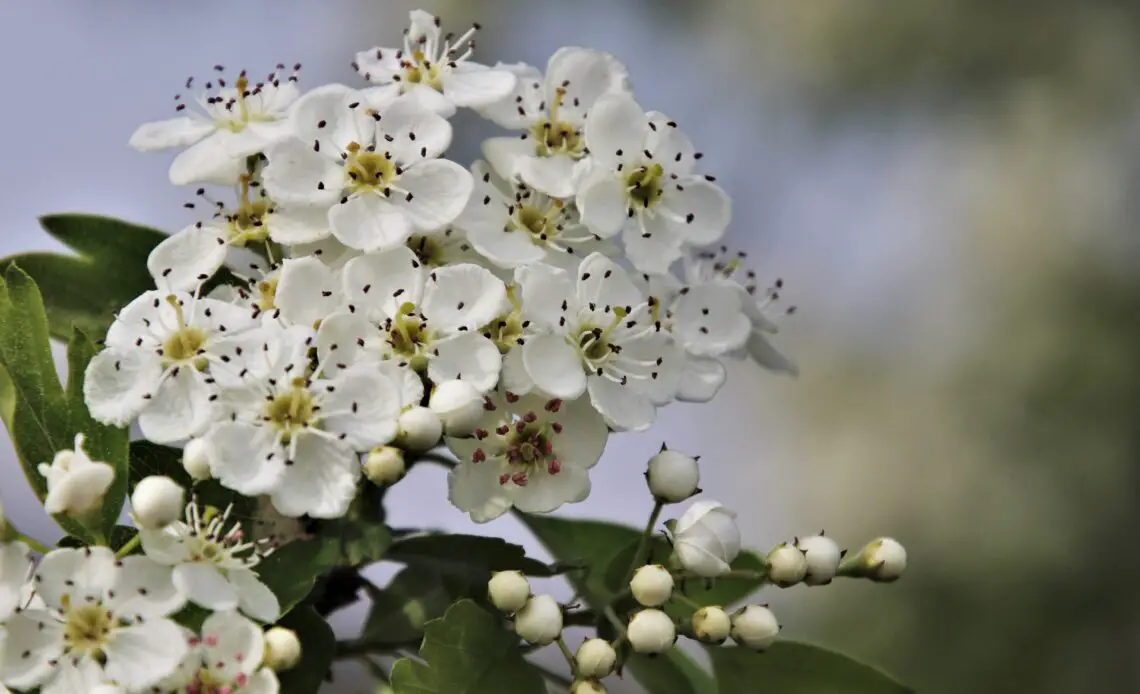
Last updated on May 21st, 2023 at 08:54 am
The hawthorn flower belongs to the family Rosaceae and the genus Crataegus. Hawthorn species are shrubs or small trees, typically 5–15 meters tall.
Etymologically, the name of the genus comes from two Greek words—Kratos, meaning ‘strength,’ and akis, meaning ‘sharp.’ These are references to the strength of the wood and the presence of thorns in some of the species. The word hawthorn comes from the Old English word hagathorn meaning ‘hedge thorn’.
The hawthorn flower is also known under many common names, including the May tree, gaxels, hagthorn, thornapple tree, quickthorn, and hawberry.
While native to the north temperate zone, hawthorn flowers are widely distributed as cultivar ornamental plants. The hawthorn flowers are white or pink, typically in clusters. The fruits are small pomes and can be red, orange, blue, or black.
What does the Hawthorn flower symbolize?
According to an Aryan myth, the hawthorn flower sprang from lightning, revealing its sacred status. Hawthorn was one of the sacred trees of Taramis, the northern Jupiter. Thus, Pyrenean peasants believed wearing a hawthorn branch, or a flower protected them against thunderbolts, lightning, and fire.
The ancient Germans used hawthorn wood for their funeral pyres after consecrating it with a mallet, the symbol of Thor. According to their belief, the sacred fire of the burning hawthorn wood carries the souls of the dead to heaven.
In the French city of Biarritz, an old custom involved making hawthorn wreaths on St. John’s day. After a prayer, the wreaths were thrown into the sea, and people believed that this act protected them from evil spirits throughout the year.
Another important part of the hawthorn flower’s meaning comes from Christianity. The Christian tradition associated the hawthorn with the Crown of Thorns.
In French, the Hawthorn flower is also known as l’Epine noble. This name is based on the belief that hawthorn branches made up the Crown of Thorns, worn by Jesus at the time of his crucifixion.
As a result, the flower has gained a mournful reputation. It is said that the hawthorn tree groans on Good Friday. Due to this connection to the Savior, it was believed that no evil spirit could enter a house where a hawthorn flower was placed.
Roman Catholic legends tell that when the Holy Crown blossomed again, the air was filled with the scent of the hawthorn bloom.
In medieval times, rosaries made of hawthorn wood were highly demanded and valuable.
The hawthorn flower is also associated with weddings and fertility. In Roman mythology, there is a story called the Abduction of the Sabine Women, in which Roman bandit men mass abducted young women from the surrounding regions.
Romulus, the founder of Rome, gave the order. His goal was to maintain the strength of Rome by increasing the city’s population. The story goes that the shepherds carried hawthorn boughs on that occasion. Since their mission was a success, the hawthorn became a promising flower.
Following this episode, branches of blooming hawthorn flowers became an emblem of men assisting during wedding celebrations. When the newlywed couple was escorted to the bridal chamber, their path was lit with torches made of hawthorn wood.
The ancient Greeks considered it a symbol of a marital union, and its tree was considered a good omen. Certain Greek wedding customs, including hawthorn flowers, have survived even today. One such custom is adorning the bride with garlands wreaths made of blossoming hawthorn twigs. The nuptial altar is sometimes decorated with hawthorn blossoms.
In an old Turkish custom, sending a hawthorn branch was a way to say that a lover wishes to receive a kiss.
Hawthorn flowers do not always have auspicious symbolism. For example, an Irish superstition goes that those who sleep in a room with a blooming hawthorn attract bad luck or even great misfortune.
According to other Irish beliefs, it is unlucky to ever bring inside the house a blossoming hawthorn. Irish countrymen also believed that the old and solitary hawthorn bushes growing in the moorlands were the most dangerous. Those belonged to the fairies; if someone plucked even a leaf from those bushes, they would invite trouble. A local legend goes that those who dare to cut down a hawthorn tree invite the wrath of the fairies.
Being a “plant of the witches,” the motif of a hawthorn flower is found in folklore and fairytales. According to one such belief, when witches marry, they make a magical potion using hawthorn and wild rose and give it to their husbands at night. This potion is so potent that it keeps the husband deeply asleep all night. The witch can then go out at night and engage in her witchery.
Since hawthorn flowers bloom in May, in old-time England, during May, young men and girls decorated the houses and churches with branches of blooming hawthorn. Abundant boughs of blooming hawthorn flowers were traditionally suspended over the doorways.
In some parts of England, there was a May-day tradition to place a blooming hawthorn branch at the door of anyone they wished to honor.
Since the hawthorn tree has a long lifespan and its wood is renowned for its durability, the plant became a symbol of longevity. The famed venerable Hawthorn Tree of the Cawdor Castle, near Inverness, is said to have stood there since time immemorial. The legend goes that the castle proprietor dreamed of a dream in which he was instructed to erect the castle over that tree.
Lastly, a curious historical incident involving the hawthorn flower made this flower an emblem of the royal house of Tudor. On August 22, 1485, Richard III was killed in the battle at Bosworth. The enemy soldiers plundered his body of its armor and ornaments, but a soldier hid his crown in a hawthorn bush. The crown was later recovered and placed on the head of Henry VII, the first monarch of the house of Tudor.
All in all, the hawthorn flower symbolic meanings are:
- happiness
- hope
- faith
- protection
- love
- fertility
- longevity
- grace
- beauty
Meaning of the Hawthorn flower colors
White color
White hawthorn flowers symbolize fertility, purity, wedding celebrations, happiness, hope, faith, and protection from evil.
Pink color
Pink hawthorn flower meaning includes expression of romantic love, youthful vitality, energy, magic, and union of opposites.
Interesting facts about the Hawthorn flowers
- The hawthorn fruits are berries with a cinnamon taste.
- Hawthorn has been used in traditional medicine to treat heart palpitations.
- The scent of the hawthorn flower could be more pleasant. This is due to the chemical trimethylamine, which is present in the hawthorn blossom.
- In the Harry Potter series, the wand of Draco Malfoy is made from hawthorn wood.
How to grow Hawthorn flowers
Hawthorn can be planted as a tree or as a hedge. They are little to medium-sized trees that are suitable for your garden. As hedges, they form a dense barrier that blooms and provides a habitat for wildlife.
- Plant the hawthorns in well-draining soil enriched with lots of organic matter.
- Place them in a spot where they can get full sun, although they can tolerate partial shade, affecting the fruit and flower formation.
- Prune the shrub quite short, starting as soon as you plant, which will cause the plant to branch out.
- Provide regular watering during summer droughts during the first year after planting.
- Apply a slow-release fertilizer formulated for trees and shrubs in spring.
- Mulch with a layer of compost, pine straw, or bark chips (keeping away from the trunk) to conserve moisture and suppress weeds.
How to care for Hawthorn flowers
- Monitor watering during dry periods for the first three growing seasons after planting.
- Once established, if the hedge or tree is growing well, fertilizer should be discontinued.
- Prune the hedges after they’ve finished flowering, usually from the end of June to the start of July.
- Remove the low side branches and shoots to encourage hawthorn to grow into trees.
- Keep moving up towards the top of the plant every year to maintain a single trunk.
Best time to gift Hawthorn flowers
Traditionally, May is the best time to give someone hawthorn flowers. In old times, girls would hang branches of blossoming hawthorn flowers on May Eve and leave them to the wind.
In the morning, the direction in which the wind had blown the hawthorn branches would determine the direction from which the girl’s future husband would come. Therefore, hawthorn flowers can be gifted to a romantic partner as a symbol of youthful romance.
Since the hawthorn tree has the reputation of being strong and living long, hawthorn flowers can also be gifted to the elderly (especially grandparents) with wishes for good health and longevity.
Conclusion
Hawthorns are low-growing shrubs to trees with a strong odor and clusters of tiny blooms. May flowers bloom all year and have beautiful flowers in the spring. The hawthorn’s 400-year lifespan lends it the symbolism of longevity, love, beauty, grace, and fertility.
These flowers not only have numerous meanings and symbolism, but they have also appeared in folklore, myths, and stories and have been utilized for many years worldwide. There is a lot to learn about the hawthorn flower, from its fabled abilities from beyond the mortal realm to its use as a corsage for brides.
If you want to know and learn more about flowers, we at PansyMaiden can help you. Check out our fun, easy-to-read, and informative flower-related content that you will surely enjoy!
